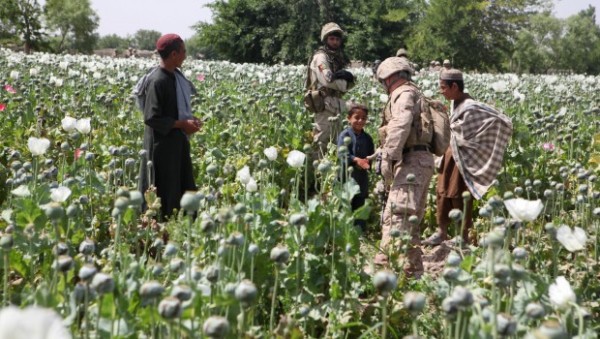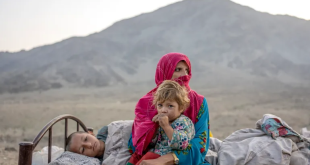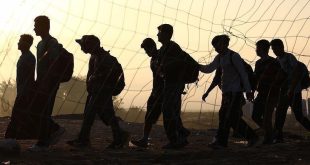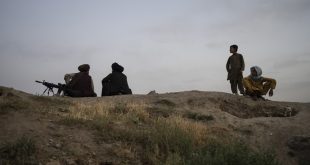By Javier Delgado Rivera
For starters, no breaking news. Afghanistan is still, and by far, the country of the world where most opium is cultivated – approximately 84 per cent of global production over the past five years.
This is the World Drug Report 2020’s top-line remark on Afghanistan, a landmark publication put out by the United Nations Office on Drugs and Crime (UNODC) that dissects the state of drug production globally, the resulting policy implications, as well as its markets and supply routes.
Although the report covers 2019, it notes that since the key months for the opium harvest in Afghanistan are March to June, the picking season took place this year right at the onset of the COVID-19 crisis. As a result, “a shortage of poppy lancers was observed in the western and southern provinces, mainly due to the closure of a border crossing with Pakistan,” found out the UNODC.
However, the scarcity of pickers was quickly dealt with as, due to the closure of schools, many poor children were sadly pushed to work in the poppy fields.

Over the last year, the World Drug Report recorded a decline in the ‘reported’ area under opium cultivation in Afghanistan – the second consecutive annual reduction, following the 2018 drought and after the 2017 record high 328,000 hectares cultivated.
In addition, and as a warning, the U.N. alerts that in 2019 the “illicit crop cultivation has started to emerge in non-traditional locations, such as Jowzjan Province.”
The long way to the drug user
It may take up to a year since opium is harvested in Afghanistan until it ends up in the streets of Western and Central Europe. As the UNODC indicates, the world’s single largest heroin trafficking channel continues to be the ‘Balkan route’: opiates from Afghanistan shipped to Iran, Turkey, and Balkan countries into Europe.
But not all drugs trafficked make it into their intended market. In 2018, Afghanistan took the world’s second place when it came to the quantity of opiates seized: 12 per cent of the world’s total, closely followed by Turkey’s 9 per cent. That year Iran was, “once again […] the country where more opium was apprehended, with 53 per cent of the global seizures,” says the UNODC.
The (synthetic) elephant in the room
Neighboring Iran is also Afghanistan’s main market of methamphetamine: an illicit stimulant which confiscation has steadily risen in Afghanistan since 2014, when manufacturing is thought to have started in the country. The 657 kg seized in the first six months of 2019 “signals a huge leap on the previous year,” warns the UNODC. The large apprehensions of methamphetamine made in other countries “thought to originate in Afghanistan, also suggest that production in the country is rising fast,” cautions the World Drug Report 2020.
According to the U.N., the use of methamphetamine in Afghanistan also appears to be increasing. Similar to the situation observed in the past in Iran, in Afghanistan this synthetic drug is frequently used along with opiates to manage their side effects, says the UNODC.
The 2018 spread of methamphetamine manufactured in Afghanistan prompted price increases for cold and flu remedies containing pseudoephedrine (used to produce this illicit stimulant) in locations where the production of this drug takes place, notes the World Drug Report 2020.
Livelihood for many, revenue for some
Opium poppy has become a crucial component of the Afghan economy, securing the livelihoods of many who engage in cultivation, work on poppy fields or partake in the illicit drug trade, stated a 2018 UNODC study.
“This illicit drug trade funds the Taliban insurgency as well as corrupt members of the Afghan government, military, and police, and also employs nearly 600,000 Afghans,” notes the U.S. Special Inspector General for Afghanistan Reconstruction (SIGAR).
As the U.N. Analytical Support and Sanctions Monitoring Team also indicates, the Taliban rely on opium poppy for revenue, supplemented by illicit mining, extortion, illegal sales and donations from abroad. “Annual Taliban income from all aspects of the illegal narcotics trade remains in the hundreds of millions of dollars,” estimates this U.N. entity
The SIGAR and the Pentagon believe that the income generated from narcotic-related activities by the Taliban to be around $1.5 billion annually.
An unruly business
At the end of 2018, the U.S. and the Afghan government ended their airstrike campaign against drug labs and opium production sites across the country. A strategy that the U.N. admits didn’t “significantly reduce the illegal drug trade” in Afghanistan.
Indeed, the overstretched authorities in Kabul have proven unable to trim this illicit – and hugely profitable – activity. “Lack of governmental presence and security are driving factors for opium cultivation, and opium cultivation further destabilizes the country by funding insurgency and anti-government groups,” stresses the UNODC.
Development initiatives to curb this crop have not fared much better. As the Organization for Economic Co-operation and Development (OECD) indicates, during 2002–2017 Afghanistan was the world’s second largest recipient of development drug control assistance, excluding funds for alternative crop cultivation. During this period, Kabul received $1.3 billion, only after Colombia’s $3.7 billion.
As a result, neither military nor development efforts to curb the cultivation, production, trade and consumption of drugs in Afghanistan have made a dent in this entrenched aspect of the country’s war economy.
Over the past 18 years the United States has spent around $9 billion to fight the drug problem in Afghanistan. Yet the agreement between the U.S. and the Taliban fails to make a single mention of the drug business in the country. And since a range of non-Taliban actors also benefits from this massive enterprise, the drug conundrum in Afghanistan will likely carry on being part of the country’s political, economic, social and rural landscape for time to come.
Javier Delgado Rivera is a New York-based freelance journalist writing about the United Nations. His articles have appeared in Carnegie Council, Huffington Post, South China Morning Post, Middle East Eye, Asia Times, and Jakarta Globe, among others.
Prior to moving to New York, Javier lived in China, India and Brussels, where he worked as communications advisor for several think tanks and advocacy groups. Javier holds an MA in Conflict Resolution from the University of Coventry (UK). He also runs @TheUNTimes on Twitter, and you can reach out to him at [email protected].
 Afghanistan Times
Afghanistan Times




